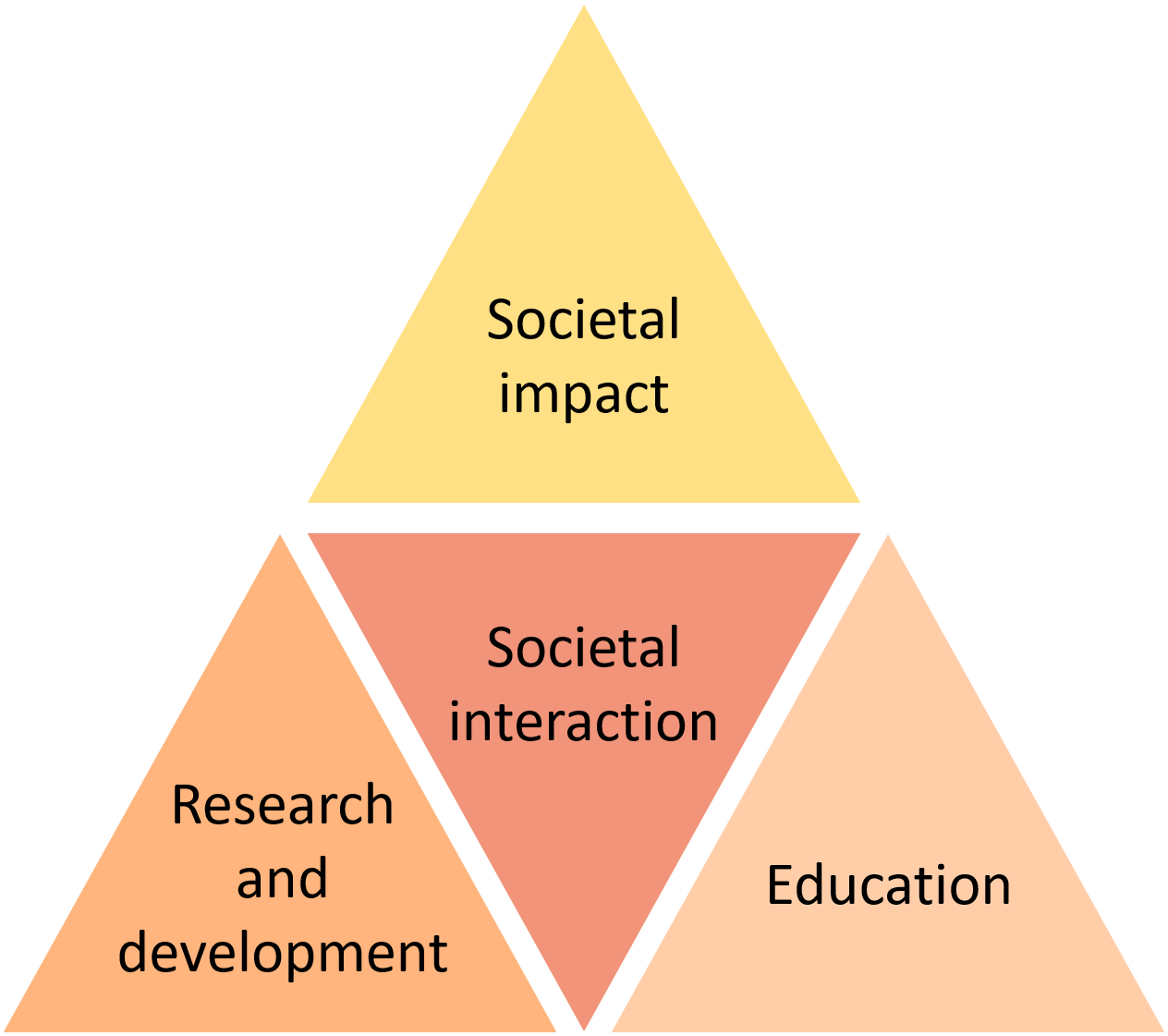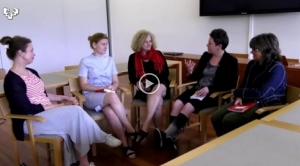
|

|
|
Aalto University, Finland, aims to shape the future by enabling systemic
solutions and accelerating innovations. Its strategic objectives
include research excellence for academic and societal impact
and renewal of society through art, creativity and design. Aalto University, Finland: Strategy for 2016‒2020 Mission: Shaping the future: science and art together with technology and business. We are building a competitive edge by combining knowledge from different disciplines to identify and solve complex challenges, and to educate future visionaries and experts. Vision: An innovative society. Breakthrough discoveries deeply integrated with design and business thinking enable systemic solutions and accelerate innovation. Values: Passion for exploration Courage to influence and excel Freedom to be creative and critical Responsibility to accept, care and inspire Integrity: openness and equality. Strategic objectives: Research excellence for academic and societal impact Renewing society by art, creativity and design Educating game changers Transforming our campus into a unique collaboration hub Excellence in advancing and supporting our core goals. Key performance indicators for societal impact: Significant corporate, public and non-governmental partnerships Employment (% of recent graduates) The strategy document: Learn more 
|
The mission of the Estonian Academy of Music and Theatre (Tallinn, Estonia)
is to contribute to the development of a human-centred Estonian
society, the spread of a creative mindset and the preservation of
the Estonian language and culture through education in the fields
of music and theatre and the promotion of creative and research
work. General principles of action and role in society In the Estonian university landscape, EAMT is responsible for music and theatre arts. According to its administrative contract with the Ministry of Education and Research, EAMT is responsible for providing musical and theatre education, meeting high standards and corresponding to the needs of society, and for ensuring the quality and development of this education. In addition to high-level specialized studies, the Academy has a regard for the broader key competencies of students, aiming to develop its graduates into responsible citizens who are able to take initiatives. The activities of EAMT are based on the constitutional principle that the main purpose of our statehood is to guarantee the preservation of the Estonian people, the Estonian language and Estonian culture through the ages. As the leading institution of musical and theatre education in Estonia, EAMT plays a crucial role in fulfilling this mission. Mission The mission of the Estonian Academy of Music and Theatre is to contribute to the development of a human-centred Estonian society, the spread of a creative mindset and the preservation of the Estonian language and culture through education in the fields of music and theatre and the promotion of creative and research work. Vision The Estonian Academy of Music and Theatre is a recognized and attractive educational and cultural centre and an exponent of national cultural traditions that actively develops international cooperation and is open to new and interdisciplinary study programmes, creative ideas and research projects. Strategic objectives to be implemented by 2020 1. EAMT shall build a hall complex next to its current main building to complete the educational environment of the Academy, raise the quality of education, improve domestic and international cooperation, and increase the visibility and impact of the Academy in society. 2. The Academy as an organization shall function in an efficient manner, with motivated employees and a modern working environment. 3. The students of EAMT shall receive a high-quality and internationally competitive education that meets the requirements of the field-specific labour market. 4. Research at the Academy shall support educational and creative activities and the preservation and development of Estonian national culture. 5. EMTA shall be an institution with a positive image, contributing to the positive evaluation of creativity and lifelong learning in society. The development plan: Learn more Societal engagement activities can be embedded in educational and RDI work. Societal interaction can be regarded as a mechanism to improve the impact of education and research and development (see Figure 1). Figure 1. Framework of societal interaction and societal impact (adapted from Lahtonen & Riitsilä 2014 in OKM 2015, 91) |
|
Due to the embedded nature of societal interaction or
engagement, communication regarding related practices
seems to be rather scarce. It is therefore difficult for an
outsider studying the web pages of HEIs to identify which
kinds of practice are followed to enhance the effectiveness
of the HEI’s basic tasks. (OKM 2015) Reference: OKM, Opetus- ja kulttuuriministeriö 2015. Vastuullinen ja vaikuttava. Tulokulmia korkeakoulujen yhteiskunnalliseen vaikuttavuuteen. Opetus- ja kulttuuriministeriön julkaisuja 2015: 13. (in Finnish) Examples of reports presenting the societal engagement practices of HEIs see on the right.  Currently many HEIs provide annual information on the outputs of their activities: the number of degrees, publications, art exhibitions, concerts, etc. When communicating their achievements, HEIs quite often fail to make the difference between outputs, outcomes and impacts. As is the case with outputs, outcomes are usually presented in figures, for example the number of start-ups or patent applications. Qualitative indicators of outcomes are mostly found in descriptions of collaborative projects with stakeholders in the context of education or research and development. However, they are not presented in an explicit manner. More discussion on the concept of societal impact is needed in the field of higher education, both within institutions, between institutions and with the stakeholders of HEIs. New societal engagement practices are being developed, yet more emphasis should be put on designing new ways of explicating the path from collaborative activities to outputs, outcomes, and finally impacts. Qualitative approaches to impact assessment are needed to elucidate the connections between changes on the individual level and the wellbeing of society. In addition, evaluating the societal impact of the whole higher education sector utilizing big data and meta-analyses might provide new insights into how to increase the societal impact of HEIs. Below is a tool for self-assesment: |
|
||
In the following table, central management issues of societal impact and societal engagement are summarized.
The left column explains WHY, HOW, WHEN and by WHOM the issue could be addressed, and the right
column provides some examples, tools and hints for further reading. This table serves several aims. Firstly, it explains why societal impact (SI) and societal engagement (SE) should be among the key areas of HEI managers’ work. Secondly, it furnishes decisionmakers with general guidelines for evaluation of societal impact and outlines key considerations in the evaluation process. Thirdly, it outlines some of the mistakes, which are common in the practice of evaluation of societal impact.The composition of the table is based on the literature review and case studies, as well as on research conducted in the HEISE project.

|
|||

|
|
|
Societal engagement impact on societies (the so-called the ‘third task’ of HEIs) have been
added to the statutory tasks of universities in the new millennium in many countries. - Societal engagement is an essential part of societal interaction, which is one target of evaluation in addition to social impact e.g. in the FINEEC auditing model in Finland. - Along with the formalization of the role of HEIs in societal engagement and impact, societal engagement and impact have become one of the key evaluation criterias for higher education accreditation organizations and providers of funds (see, for instance, the FINEEC auditing model in Finland) - The FINEEC auditing model examines societal impact from a procedural point of view. The idea is to support HEIs in determining their societal impact based on their profile, and to translate it into the overall culture of higher education. It is highly relevant how the HEIs are able to demonstrate and report the societal impact of their own activities. - Societal engagement and impact matters for stakeholders of HEIs, and therefore is one of the determinants of an HEI’s competitiveness and funding considerations. - Demonstrating and reporting positive societal engagement and impact can eventually result in larger financial benefits and in the likelihood of being invited into the process of solving societal issues in the future. |
Social Impact and Societal Interaction
& FINEEC audit model here Global RCE network for Education for Sustainability here United Nations University for sustainability here |
|
Demonstration of HEIs’ societal engagement and impact has increasingly become a requirement
set by funders, policymakers, supervisory agencies and other stakeholders of HEIs. - In EU policy guidelines, HEIs have been challenged to respond to societal challenges, for example in complementary research funding instruments such as the Horizon2020 funding program. - Co-creation and end-user involvement in development work is emphasized in EU policy papers and financial documents. Societal engagement is an essential approach to organize these activities of co-creation. |
Public Engagement in Responsible
Research and Innovations here Expert group on the economic and societal impact of research and innovation (ESIR) here |
|
Sustainable development and social responsibility are nowadays key areas of strategy and competence
in working life. - The societal engagement and societal impact of HEIs are strongly linked to sustainable development, to (corporate) social responsibility and to the idea of creating shared value (CRV) with the working life partners (companies and other organizations) of HEIs - It can be assumed that partners and main stakeholders of HEIs increasingly appreciate HEIs’ contributions in this area of sustainable development. |
UN AGENDA2030 for sustainable development
here Corporate Social Responsibility & the EU here About Shared Value here |
|
Societal engagement and impact have an internal value by providing meaning to HEI
teams and individual employees. - Societal engagement as a core value of HEIs established in value and mission statements provides a solid ground for the education and research activities of staff. - Deeper meanings behind HEIs’ objectives are important for both staff and external stakeholders to know why they are doing what they are doing and how all of this is related to the betterment of society. |
Visual Arts organisations and Societal
Engagement: here |

|
|
|
The implementation of societal engagement and impact is a key part of HEIs’ strategy. - Societal engagement can be approached from various perspectives including social, artistic, entrepreneurial, managerial and economic activity, which offer multiple ways for HEIs to engage with society. Increased societal engagement increases the opportunities for societal impact. - Societal impact analysis can be used as a complement to financial analysis in strategy formation, and in the process of designing and making changes in activities, projects or educational programs. Even though the impact analysis may suggest different decisions from the financial analysis, eventually in the longer run the decisions adopted on the basis of societal impact are likely to also payoff financially. |
Finnish Education Evaluation Center
(FINEEC) auditing manual for higher
education here The social impact and interaction of universities in Finland in Finnish here Sustainability Impact Assessment in Higher Education - a review of tools and indicators here Evaluation: Practical Guidelines. A guide for evaluating public engagement activities. People Science & Policy Ltd., for the Research Councils UK, BIS and the NCCPE (2011) here |
|
The societal engagement and impact of HEIs start with acknowledging how pedagogical
approaches support community engagement in everyday learning and R&D processes. - For example, LAUREA University of Applied Sciences’ Learning by Developing (LbD) pedagogical model integrates competence-producing learning and innovative R&D projects through which learning opportunities are created alongside the development of R&D projects. The characteristics of the LbD model are authenticity, experiential nature, partnership, research-oriented approach and creativity. |
Learning by Developing pedagogical
model in higher education here Learning by Developing - case studies 2018 Case studies in Theory and Practice |
|
Societal impact assessment and societal engagement planning are essential parts of project
planning and management. - Societal impact is a consequence of collaborative actions in society, which is often linked to the instrumental value of societal engagement. However, societal engagement can also create intrinsic value and impact by enabling citizens to participate in developmental work with creative methods. |
Toolkit on public engagement with
science here Toolkit for engaging society in responsible innovation Promoting societal engagement in research and innovation: Moving towards Responsible Research and Innovation Guidance for accessing and managing the social impacts of projects: by International Association for Impact Assessment here |
|
The management of societal impact covers the levels of organization, project, activities,
and finally the individual level -Understanding an organization’s societal impact requires also understanding societal impact at the practice level of HEI staff. - Societal impact assessment (SIA) is based on the utilization of local know-how and joint development with affiliate and interest groups. Comprehensive SIA work requires multidisciplinary and wide-ranging expertise, which is why it usually involves several people. -By evaluating societal impact at the individual level, HEIs acknowledge and signal that there are more than individual-specific financial costs and benefits that matter for HEIs. Understanding societal impact at the individual level also allows HEIs to understand and measure more accurately the marginal contribution of an individual to the achievement of organizational goals. |

|

|
|
|
Pre-evaluation (ex-ante) estimates the expected societal impact and focuses on intended impacts. - The aim of pre-evaluation (ex ante) evaluation is to estimate the expected societal impact and thereby assist organizations in the decision-making process. Estimates of expected societal impact help organizations to plan their activities and allocate resources in a way, which maximizes the (positive) desirable impact. The estimates also help to justify the funding, which is conditional on expected societal impact. - Pre-evaluation (ex-ante) is based on expected outputs, outcomes and impact. These expectations can be formed based on the organization’s previous experiences, best practices from similar organizations, and the findings of empirical studies, or formed based on the theory - In the impact assessment, it is important to analyze the potential positive and negative impacts# from the viewpoint of various regulations and of various codes of conduct, including Fundamental Rights of Citizens. - Organizations planning and evaluating societal impact of their activites should be aware of different types of impacts, possible time it takes for impacts to realize, and should not forget to consider also the role of other factors (besides their activities) in the occurred changes in the society. - Societal impact should not be confused with outputs, as often it occurs in practice. It is important to note that a clear distinction between impacts and outcomes is often difficult. Therefore, it may be proposed that the term “impact” can be used for both shortterm short-term and long-term consequences. A clear distinction, however, should be made between outputs and impacts (or outcomes). As Mills-Scofield (2012) summarizes briefly, but effectively: “Outcomes are the difference made by the outputs.” In practice, however, this important distinction is often forgotten and many societal impact reports tend to focus on outputs rather than on impacts. A typical roadmap used in societal impact studies: inputs – activities – outputs – outcomes – impacts, would help to map the path from activities to impact. - As suggested by the conceptual framework of societal impact, which was developed as a part of the HEISE project, the ex ante evaluation of societal impact should focus on mapping the existing individual preferences and constraints faced, and thereafter specify the expected changes in these preferences and constraints along with the expected changes in optimal choices by individuals – members of society. - Despite of its potential key role in achieving impact-related goals, ex ante evaluation is not yet a common practice among HEIs. However, the HEIs should acknowledge that achievement of strategic goals specified in their mission statements, requires also more widespread application of ex ante evaluation of societal impact. |
ASSERT project SI Toolkit for Societal Impact Assessment in Security Research INACHUS ethics deliverable including SIA here RANGER ethics deliverable including SIA here |
|
Post-evaluation (ex-post) considers actual impacts and should include a wider spectrum of impacts,
including intended as well as unintended and positive as well as negative impacts. -Post-evaluation (ex-post) of societal impact at the organizational level is usually conducted with fixed frequency (annually) or conducted on an ad hoc basis (e.g. required for the institutional accreditation of HEI). The need for SI assessment could arise internally or could be imposed externally, by either regulators, accreditation institutions, or funders - Our research suggests that ex post evaluation is by far the most common type of evaluation applied in practice. However, it is often forced by external requirements or expectations, rather than induced by internal needs of HEIs. -Post-evaluation (ex-post) considers actual outputs, and focuses on the outcomes and impacts effected. Compared to pre-evaluation, the post-evaluation of SI relies on larger information sets and involves less uncertainty. Post-evaluation can be conducted based on the observed behavior of individuals or by using contingent valuation methods (surveys), which address activity-led changes and causality at idividual level. Such changes could involve changes in the constraints and preferences of individuals. -The post-evaluation (ex-post) should be appropriately timed and should take into account that some impacts are not revealed immediately. Hence, studying societal impact immediately after the completion of activities may lead to incorrect estimates of societal impact. If societal impact occurs with a time lag, immediate post-evaluation results in an underestimation of SI. However, if the changes (impact) do not persist over time, then immediate post-evaluation overestimates the true SI. To address issues of time lag, the distinction between outcomes (as short-term impacts) and impacts (as long-term, lasting impacts) should be made clear. Moreover, to improve the accuracy of estimates, it is advisable to use repeated post-evaluations (ex-post). - Societal impact should be evaluated by qualified persons who understand the concept of societal impact, the path of impact and the methodology of estimating SI. - As suggested by the conceptual framework of societal impact, which was developed as a part of the HEISE project, the ex post evaluation of societal impact should focus on the actual changes in the individuals’ preferences and constraints faced, along with the expected changes in optimal choices by individuals – members of society. |
FINEEC auditing reports including SI
aspects: here LAUREA’ societal impact and interaction report 2017 here SAIMIA yhteiskuntavastuuraportti 2015 here Net Promoter Score (NPS) assessment for assessing the effectiveness/ impacts of training and RDI activities. here |


 Societal impact emerges from various societal
engagement practices, and interaction with
different actors in society on a local, regional
or global level. Thus, societal engagement is
a strategic activity for HEIs, which is aimed at achieving the strategic goals and impact consistent with the mission and vision statements of organization. Mission and vision
statements are the foundational guidelines
for societal engagement. Strategic goals may
address the objectives of societally impactful
education, new knowledge creation in research
and development, collaboration in national
and international networks, and the impact and
renewal-oriented organizational culture of
the HEI. See below some examples of HEIs’
strategic goals:
Societal impact emerges from various societal
engagement practices, and interaction with
different actors in society on a local, regional
or global level. Thus, societal engagement is
a strategic activity for HEIs, which is aimed at achieving the strategic goals and impact consistent with the mission and vision statements of organization. Mission and vision
statements are the foundational guidelines
for societal engagement. Strategic goals may
address the objectives of societally impactful
education, new knowledge creation in research
and development, collaboration in national
and international networks, and the impact and
renewal-oriented organizational culture of
the HEI. See below some examples of HEIs’
strategic goals: